Star Trek: Deep Space Nine Third Season
Original air dates: September 1994 – June 1995
Executive Producer: Rick Berman
Executive Producer: Michael Piller (through to “The Die is Cast”)
Executive Producer: Ira Steven Behr (“Through the Looking Glass” forward)
Station log: The third season of DS9 is the first season of the show where the show aggressively takes on the notion of serialization and of forward movement of various plotlines. It begins in the very first episode when we get the addition of the U.S.S. Defiant and Odo learns who his people are. In addition, the Dominion threat hangs over the entire season, seen more overtly in “The Abandoned,” “Heart of Stone,” “The Die is Cast,” and “The Adversary.”
Other threads are picked up on and continued: we go back to the Mirror Universe in “Through the Looking Glass,” and the Maquis remain a going concern particularly in “Defiant” and “Heart of Stone.” Of course the Bajoran-Cardassian relationship has some twists and turns, including a new treaty in “Life Support” that results in a new communications relay in “Destiny,” plus we get significant looks into the politics of both worlds in “Second Skin,” “Improbable Cause,” “The Die is Cast,” and “Shakaar,” as well as reminders of the history between those two worlds both in the distant (“Explorers”) and recent (“Civil Defense”) past.
Most important, though, is the character work done. While Odo’s reunion with his people in “The Search, Part II” ends poorly it does provide him with more knowledge of who and what he is, leading to him taking on crew quarters and putting aside his bucket so he can explore his shapeshifting more thoroughly in “The Abandoned.” Sisko gets to let out his inner badass, mostly while pretending to be someone else—his Mirror Universe counterpart in “Through the Looking Glass” and Gabriel Bell in the “Past Tense” two-parter—and also gets to answer a centuries-old question about Bajor’s space-travel history (“Explorers”) and get a girlfriend (Kasidy Yates in “Family Business”). Dax learns about a host she never knew she had (“Equilibrium”) and gets to meet all of her previous hosts (“Facets”). We learn a bunch about Kira’s past (“Second Skin,” “Shakaar”) even as she loses her boyfriend (“Life Support”). Quark has to deal with both his mother (“Family Business”) and his wife (kinda, in “The House of Quark”). And the O’Brien-Bashir bromance is deepened, from the dart board making its first appearance (“Prophet Motive,” being ensconced in Quark’s in “Visionary”) to their drunken affirmation of their friendship in “Explorers.”
Even the recurring characters got a great deal of development. Nog announced that he wanted to join Starfleet in “Heart of Stone,” and took his preliminary entrance test in “Facets,” which were also two of the three episodes in which Rom actually stood up to Quark (the third being “Family Business”). We got some insights into Dukat’s family life in “Defiant,” and we learned a good deal more about Garak in “Improbable Cause” and “The Die is Cast.”
Highest-rated episode: “Improbable Cause,” the season’s only 10.

Lowest-rated episode: “Meridian,” the season’s only 1.
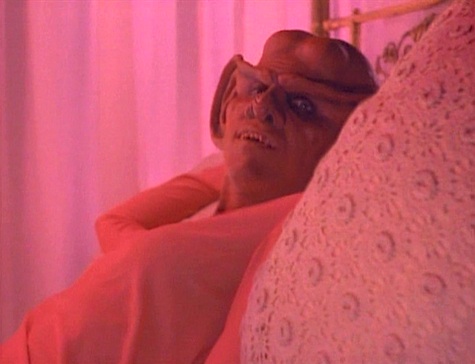
Most comments (as of this writing): “The Die is Cast” with 70. Status quo changes FTW!
Fewest comments (as of this writing): “Distant Voices” with 12. Nobody wants to talk about what goes on in Bashir’s head, obviously…
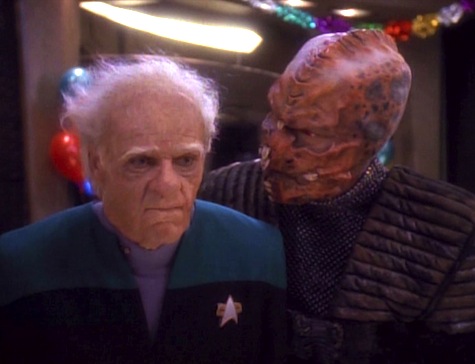
Favorite Can’t we just reverse the polarity? From “Civil Defense”: Lotsa technobabble in this one, mostly from Dax when she jiggers with ODN conduits and reroutes secondary whozamadingitzes, and so on. We also get a smattering from Dukat and Garak (and surprisingly little from O’Brien). Also, as just indicated, it’s pretty neat that the station can lose life support, the power grid, and the fusion reactor, and yet the lights and doors still work….
Favorite The Sisko is of Bajor: From “The Abandoned”: Sisko has Mardah over to dinner with the express purpose of, as O’Brien puts it, lowering the boom on her relationship with Jake, but as dinner progresses he learns quite a bit. As expected, he learns more about Mardah—that she’s an orphan, that she’s a budding writer—and she also has some pointed remarks about people who judge her solely on the basis of her job. (Sisko briefly looks chastised when she says that.) As not expected, Sisko also learns many things about Jake, including that he writes poetry and that he hustles dom-jot.
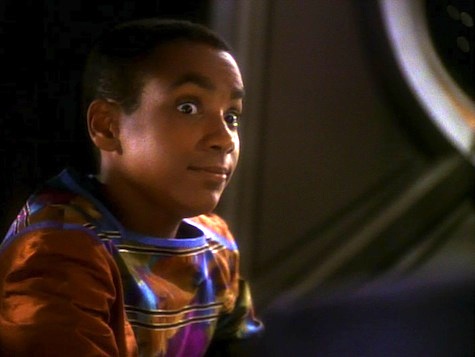
Favorite Don’t Ask My Opinion Next Time: From “Second Skin”: Kira handles her imprisonment with gusto, not budging an inch with either Entek or Ghemor. It isn’t until she sees the recording of Iliana that she starts to lose it, but she also instantly figures out Entek’s plan once she realizes that Ghemor is a dissident. The one thing we don’t know is how Entek knew about her childhood memory, but he could’ve gotten that out of her with truth drugs before her “official” waking up in the Ghemor house. (We’ve seen Cardassians use such in the past, notably in “Chain of Command, Part II.”)
Favorite Rule of Acquisition: From “Destiny”: We get quite possibly the two best Rules—#34 (“War is good for business”) and #35 (“Peace is good for business”), which Quark admits are easy to confuse with each other. In addition, the original script had a Rule that was not used in the final teleplay, but which Ira Steven Behr liked so much, he included it in the books The Ferengi Rules of Acquisition and Legends of the Ferengi: “Faith can move mountains of inventory.”
Favorite Preservation of mass and energy is for wimps: From “The Search, Part I”: For the second time, Odo gets pissed at the presence of a Starfleet security officer assigned to the station, and his interactions with Sisko on the subject of Eddington mirror those he had with the commander regarding Primmin in “The Passenger.”
Odo also at the end of the episode finds his people’s homeworld in the Omarian Nebula. For reasons passing understanding, they all go into humanoid form with the same unfinished look that Odo has, even though Odo only has that form because he can’t do anything more detailed. It’s an understandable bit of visual shorthand to make it clear to the viewer that these are Odo’s people, but it doesn’t make any kind of story sense.
Favorite The slug in your belly: From “Past Tense, Part I”: Dax’s super science officer-ness comes into play here, as she not only effortlessly creates an identity for herself with a computer interface, (no Montgomery Scott saying “Computer” into a mouse here…), but she also never misses a beat when explaining her situation, unhesitatingly referring to her combadge as a brooch and her spots as tattoos. So often these things are played broadly, in a manner that realistically would raise red flags to the person being spoken to, but instead Dax slides effortlessly into the 21st century, as you would expect a professional science officer (and person with three centuries’ experience) to do.
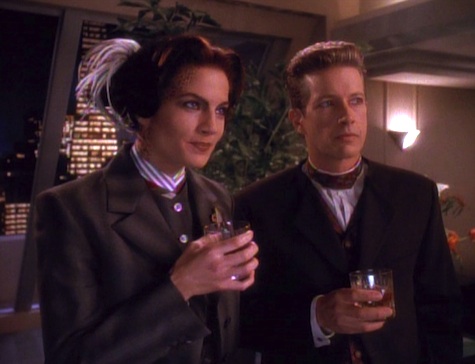
Favorite For Cardassia! From “Explorers”: Cardassia’s official position is that Bajorans couldn’t possibly have visited Cardassia before the latter achieved faster-than-light travel. When Sisko proves that it could’ve happened thanks to the tachyon eddies near the Denorios Belt, the Cardassian government all of a sudden reveals an archeological find of a Bajoran solar sailboat from eight hundred years earlier. It’s a Christmas miracle!
Favorite Plain, simple: From “Civil Defense”: The bad history between Garak and Dukat that was hinted at in “Cardassians” gets more play here, as apparently there was some manner of interaction between Garak and Dukat’s father that ended with Dukat’s père being put on trial (and as we know from “The Maquis, Part II” and “Tribunal,” Cardassian trials always end the same way). And just in general, Dukat and Garak spend a lot of time sniping at each other, including Dukat saying the whole trip was worth it to see Garak cowering in a corner to avoid the disruptor fire, while Kira spends a lot of time telling them to stop comparing dick size and actually work at solving the damn problem.
Favorite What happens in the holosuite, stays in the holosuite: From “Heart of Stone”: O’Brien has been taking Odo kayaking on the holosuite. Odo enjoys it, though O’Brien does all the singing (“ancient sea shanties” such as “Louie Louie”).
Favorite Victory is life: From “The Search, Part I”: We learn that the Founders of the Dominion are rarely seen, and considered mythical by many members of the Dominion, including the Karemma. This confirms what Eris said in “The Jem’Hadar” (since she was a spy, all her information has to be considered suspect). The Dominion is administered by the Vorta; people in the Dominion do what the Vorta say or the Vorta send in the Jem’Hadar. (That the Vorta is Eris’s species has not yet been established.)
Favorite Tough little ship: From “Defiant”: Hilariously, I had chosen this header for the section on the Defiant based on Will Riker’s line in First Contact, having completely forgotten that Tom Riker said the exact same thing about the ship in this episode. Ronald D. Moore scripted both movie and episode, so the movie line was probably a deliberate callback. Either way, it fits, as the Defiant destroys an outpost and two ships with only minimal damage to itself. (Kira does more damage with her sabotage, truly.)
Also we get our first mention of quantum torpedoes, which are apparently bigger and badder than photon torpedoes….
Favorite No sex, please, we’re Starfleet: From “Fascination”: Where do I even begin….
Jake, having broken up with Mardah, hits on Kira, who is hit on (and hit on back) by Bashir and is no longer being hit on by Bareil, who’s hitting on Dax, who’s hitting on Sisko (leading to Bareil hitting Sisko). As an added bonus, Quark hits on Keiko. Given the red dress she’s wearing, I’d have hit on her too. And Lwaxana spends the entire episode hitting on Odo, to no avail, though she does get in a kiss at the end.
Favorite Welcome aboard: This season sees the debut of several new recurring characters: Jeffrey Combs as Brunt (“Family Business”), Salome Jens as the female changeling (“The Search” two-parter, “Heart of Stone”), Penny Johnson as Yates (“Family Business”), William Lucking as Furel (“Shakaar”), Kenneth Marshall as Eddington (“The Search” two-parter, “The Die is Cast,” “The Adversary”), Chase Masterson as Leeta (“Explorers,” “Facets”), Julianna McCarthy as Mila (“Improbable Cause”), and Duncan Regehr as Shakaar and Diane Salinger as Lupaza (both in “Shakaar”). Plus, Robert O’Reilly comes over from TNG to make his first of many appearances on this show as Gowron in “The House of Quark.”
Previously established recurring guests show up as well: Marc Alaimo as Dukat, Philip Anglim as Bareil, Majel Barrett as Lwaxana, Felecia M. Bell as Jennifer, Leslie Bevis as Rionoj, Rosalind Chao as Keiko, Paul Dooley as Tain, Aron Eisenberg as Nog, Louise Fletcher as Winn, Ann Gillespie as Jabara, Max Grodénchik as Rom, Hana Hatae as Molly, Natalija Nogulich as Nechayev, Andrew J. Robinson as Garak, Wallace Shawn as Zek, and Tiny Ron as Maihar’du.
Other nifty-keeno guests include Mary Kay Adams (“The House of Quark”), Erick Avari (“Destiny”), John Doman (“Shakaar”), John Fleck (“The Search, Part I”), Martha Hackett (“The Search” two-parter), Annette Helde (“Visionary”), Bari Hochwald (“Explorers”), Clint Howard (“Past Tense, Part II”), Tina Lifford (the “Past Tense” two-parter), Andrea Martin (“Family Business”), Frank Military and Dick Miller (both in the “Past Tense” two-parter), Tricia O’Neil (“Defiant”), Leland Orser (“The Die is Cast”), Lawrence Pressman (“Second Skin,” “The Adversary”), Wendy Robie (“Destiny”), Joseph Ruskin (“The House of Quark,” “Improbable Cause”), Tim Russ (“Through the Looking Glass”), Leon Russom (“The Die is Cast”), Jill Sayre (“The Abandoned”), Tracy Scoggins (“Destiny”), Jack Shearer (“Visionary”), Gregory Sierra (“Second Skin”), Bill Smitrovich (the “Past Tense” two-parter), Deborah Van Valkenberg (“Past Tense, Part II”), and Lark Voorhies (“Life Support”).
But the big guest this season is Jonathan Frakes, who shows up letting everyone think he’s appearing as Will Riker, only to pull a bait-and-switch and be Tom Riker from TNG’s “Second Chances” in “Defiant.”
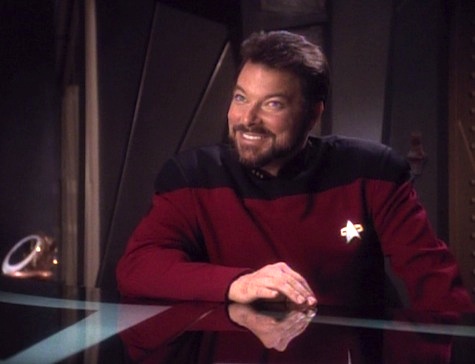
Favorite Keep your ears open: From “Second Skin”: “I’ll go along on your fool’s errand, but I want one thing to be perfectly clear: I have no intention of sacrificing my life to save yours. If it looks like we’re in danger of being captured, if there’s any sign of trouble at all, you’re on your own.”
“Mr. Garak, I believe that’s the first completely honest thing you’ve ever said to me.”
“How perceptive of you, Commander.”
Garak and Sisko, both speaking truth.
Favorite Trivial matter: Probably the one for “Defiant,” for what the episode established, for what it picked up on, and for the number of ways it was followed up on in the tie-in fiction.
Walk with the Prophets: “Begin Captain’s Log, Stardate 48960.9.” There is much to admire about this season. For starters, it redresses two flaws from the show’s earliest days. In “The House of Quark,” Keiko is no longer being unconvincingly crowbarred into the role of schoolmarm, and instead is allowed to be what she was established way back in TNG’s “Data’s Day” as being: a botanist. And then at the end of the season, Sisko gets a long-overdue promotion to captain.
Plus, the character work this season is superb. Of particular note is some stellar acting, particularly Nana Visitor’s refusal to give in when confronted with the idea of being a Cardassian sleeper agent in “Second Skin,” Avery Brooks trying to survive the 21st century in the “Past Tense” two-parter, Rene Auberjonois’s impressive display of Odo’s evolution over the course of the season, pretty much every single moment Andrew J. Robinson is on screen, and, perhaps most impressively, Aron Eisenberg’s heartfelt delivery of Nog’s explanation of why he wants to join Starfleet in “Heart of Stone.”

But ultimately, rewatching this season has led me to a similar feeling of mild disappointment that I got after I finished TNG’s fifth season. Some true high points, but an overall sense that the season wasn’t all it could have been. Yes, there are some great episodes here—“The House of Quark,” “Second Skin,” “Defiant,” and especially the “Improbable Cause”/“The Die is Cast” two-parter are brilliant, and the “Past Tense” two-parter is a very well done piece of Trek social commentary—but also a lot of episodes that are less than they could’ve been. Some are done in by poor acting (“Equilibrium,” “Life Support”), others by plot holes (“Civil Defense,” “The Adversary”), or both (“Meridian,” “Fascination”).
And perhaps the biggest disappointment is that “The Search” two-parter gave us so much wonderful setup for the future—and then very few of the subsequent 24 episodes did a damn thing with it. Talak’talan said in “The Jem’Hadar” that the Dominion would view any entry to the Gamma Quadrant as an act of war, yet the Defiant went into the GQ in “Meridian” with no consequences whatsoever. More fundamentally, though, the Dominion threat was either nonexistent or passive until the season finale. The Jem’Hadar baby threatened the station in “The Abandoned,” but his arrival was an accident (though that episode did showcase how brutal the Founders are in their genetic manipulation of their soldiers). The female changeling’s actions in “Heart of Stone” were designed to learn more about Odo, not threaten the Alpha Quadrant. Even the Dominion’s biggest victory of the season, in “The Die is Cast,” was a reaction to someone else’s plan, and they won by exploiting Tain’s hubris.
For that matter, we’re given a shiny new ship in the Defiant, and precious little is done with it. Sisko takes it to Trill in “Equilibrium” for a mission that a runabout would be better suited for, and its use in “Meridian” isn’t much of an improvement. The ship gets to kick ass and take names in “The Die is Cast,” but the episode gains nothing by the Defiant’s presence, indeed would’ve been just as effective without it. Hell, the Maquis get better use of the ship when they steal it in “Defiant.”
The exception to the above two paragraphs is “The Adversary,” but it’s unfortunate that it took an entire season to do something substantive with either the Dominion threat or the ship that was assigned to DS9 to deal with same.
Warp factor rating for the season: 6
Keith R.A. DeCandido is thrilled that fellow Tor.com blogger Ellen Cheeseman-Meyer has waxed rhapsodic on the subject of my Trek novel A Time for War, a Time for Peace on this here site.










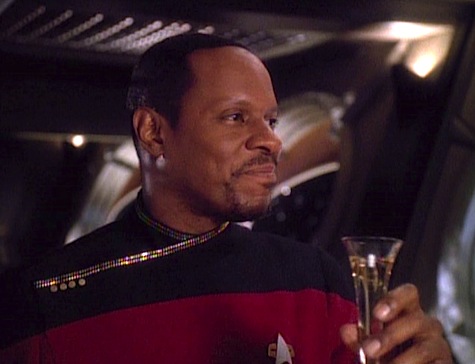
For all its flaws, this season is still where DS9 became what is in our thoughts when we think of the show. The groundwork is laid for the two major arcs that will dominate the rest of the show, Sisko — who had been relegated to a bit player in many ways in the first 2 seasons — has come into his own, most of the characters have real depth and background, even one or two of the secondaries like Garak. Now we strap in for 3 very solid seasons and then one that, as with TNG, has some highpoints, but also has some very low lows.
It seems like so far the Dominion/Jem’Hadar have just been hinted at but only in small, tantalizing ways. You know they’re out there, but there isn’t much done with them…yet (I suppose I don’t have a true ‘first timer’s’ perspective since I do know that they do show up in more force later on, so I didn’t feel like we were getting short changed here).
Also, I had apparently completely wiped that image of Quark+Kira’s body out of my brain, THANKS A LOT, now I’ll probably never forget it, haha.
The absolutely horrible The Die is Cast was it for me. I stopped watching DS9 from that point on. In fact, I went from a fairly reliable Trek watcher to someone who has really never seen much of anything past DS9 (isolated Voyager and Enterprise, but nothing extensive).
Just like every sci-fi show would have its plague episode, there was this push to give every show its “torture” episode. Generally this was supposed to show off the acting ability of the lead; this is how TNG and Babylon 5 approached those episodes. They at least treated the topic with some modicum of seriousness, though they always ended with the lead character successfully resisting and refusing to break (everyone eventually breaks in torture; everyone).
The Die is Cast made an absolute mockery of the topic. Garak tortures Odo (it does not matter that he was directed by someone else) and then their relationship is reset by the end of the episode. This was a sign to me that the writers were not going to take this show seriously.
#3
If you haven’t seen any DS9 past The Die is Cast, then that’s totally your lose. There are some fantastic episodes to come in the rewatch… sooner rather than later….
@3: I don’t think it’s true that “The Die is Cast” made a mockery of torture. On the contrary, it showed that torture isn’t about legitimate interrogation, but about breaking someone’s will and dominating them psychologically. It didn’t matter that Odo had no useful military intelligence; breaking him meant getting him to confess his secret, even though it was a personal secret that didn’t benefit the Cardassians in the least. It was a hollow exercise in sadism and domination, and Garak realized that. It made him recognize, perhaps for the first time, what had been wrong with the actions he’d performed for the Order in the past, and made him see that Tain’s approval was not as much worth winning as he’d thought, if Tain was the sort of person who’d order him to do something so cruel for no good reason other than to exert power.
And that’s why it’s not wrong that Odo forgave him: because Odo recognized that Garak was a victim too in that situation, that he’d done something he didn’t want to do because Tain commanded it and he believed it was the only way to regain his old place in the Order, and that the experience made him realize he didn’t want to go back after all.
My biggest surprise was realizing that Sisko didn’t go full “Hawk” until Season 4…I could have swore it started w/Season 3, but I guess I’m thinking that’s because he grew the goat at the end of the season. Of course, I think it’s funny that he didn’t keep his head shaved until afte his last appearance as Hawk (If my memory is correct -Season 4 started in fall ’95, and I’m pretty sure the last Spenser movie aired just before then) -but maybe it was a contract issue? or it was a filming thing – production on the last Spenser movie and the beginning of Season 4 were too close together for him to regrow his hair?
Oops. Correction to my earlier post. That should be “your loss” not “your lose.” Darn typos.
“it’s pretty neat that the station can lose life support, the power grid,
and the fusion reactor, and yet the lights and doors still work….”
Emergency systems I’d imagine. I worked at a pet store for a few years and we lost power one winter. Backup generators kept some of the lights and fish filtration going for awhile. Not everything needs to have a single power source, so I’d expect low-power things like lights to still work especially given they’ve had a few centuries to advance beyond LEDs.
@3
What you said about the main character successfully resisting and refusing to break; maybe you should re-watch the end of Chain of Command (Part 2). Picard admits to Troi that he DID break, that he saw five lights.
wow Teaks1948, I bet you have a nigerian prince uncle too!
now back to DS9, for me the two surprise highights of this season were the development of the Ferengi and Garak. The Ferengi: I love Nog deciding he is going to go to Starfleet and the interactions between Quark and Rom over it. The Ferengi went from basically a race characterized by greed, to something much more sophisticated and interesting. Plus, the Ferengi charcters just became fun to watch this season. Garak as the super secret maybe ex-spy… who doesnt love a good spy story.
For me these two new story lines really elevated the serieas to make it unique and different than the typical Trek with federation officers on a starship. you started to feel like it was a real space station with lots of different cultures and stories going on simultaneously.
Attention everybody, attention everybody! *walks in ringing a cowbell* For one thing I appreciate very much what is being done here and I can’t wait for the beginning of the fourth season. However, I am here for another, more pressing question. And I’m giving you a warning: This question may prove so controversial some of you are going to have an aneurysm.
Anyway, here it goes….*draws deep breath*
When is Tor.com doing the Christopher Paolini’s Inheritance Cycle Reread? Okay, I admit, the books aren’t free of cliches, and the style is amateurish, and inconsistencies appear often, and it’s even possible Paolini may have ripped off *a few* things on the way, but dammit, the man has talent. I mean, he began work on the books when he was only fifteen years old and the first one was published, like five years later, and now he is thirty and he has already finished his first series of fantasy books (how many fantasy authors do you know of who have accomplished this feat?). And when his books proved have proved very succesful and have even spawned a film when only two of the books were released (by the way, I’m glad that the Eragon film isn’t going to get any sequels), you’d certainly notice that some people don’t mind the unfavorable similarities.
Also, his books are written on such a level of detail that I fell in love with them. And I expected that level of detail to be also found in Tolkien and was sorely dissappointed when I first opened up The Fellowship of the Ring and didn’t found that level of detail (by the time I finished The Return of the King I was long, long since not dissappointed anymore), so you have have an idea of how I expected other books (of any genre) to be. And, of course, these books captivated me, so there’s the final reason for which I want such a good site as this to do an analysis of them. The Inheritance Cycle gives a lot of food for the thought, themes, and other questions to answer or reflect to.
All I ask is for an Inheritance Cycle Reread, where the individual books are analyzed chronologically (not necessarily chapter-by-chapter, since each of the books is so long that they have many chapters each) and other questions are asked along the way. Also, I’d like that each section contained a part where it’s explained and mentioned the influences, allusions, and references to other works (and perhaps even to events of real life) that Paolini constantly makes thoughout his work (plagiarizes, according to some of you), since I haven’t seen all movies and haven’t read all books (and haven’t watched all TV shows).
(I’d also ask for the etimologies of each of the names that appear on the work, but I think that is too much to ask.)
I think one or several of the staff members of Tor.com could do it. Perhaps you should do it.
I’d really appreciate that.
P.D. Since we are already at it, how about a chapter-by-chapter reread of each of the Harry Potter books?
I can’t say I was surprised or disappointed while rewatching this season. It was pretty much how I remembered it.
I always felt that the first two seasons were just a variation on the Trek theme. Interesting and often entertaining, and in the main useful because they established the new set of characters, allowed them to grow, and allowed us to become accustomed to and really quite fond of them. Then this season was where you started to see that it could be something more than that, that rather than just following the standard Trek pattern it could become something unique in its own right even while existing in the Trek universe (something Voyager really never did).
But I always remembered it as being season 4 where it actually fulfilled that promise. In fact I’ve always thought of it as a kind of reverse Samson scenario. It gained its strength and awesomeness when Sisko stopped having hair.
This was the most unique season of all the series, one of transition from the early chapters of seasons 1 and 2 to setting up the next chapters, with story arcs that will dominate the rest of the series. So much awesome seen and so much more to come. Season 3 always stands out in my mind, not for having the most good episodes or anything like that (though it obviously has quite a few gems), but for really setting the stage going forward, with Sisko finally getting that fourth pip as a finishing touch.
Next up….
(Spoilers)
…WORF!!!!
MattHamilton, like that’s a spoiler. I mean, we knew since the start of this season that DS9 would be characterized by ongoing worfare.
(sorry sorry the devil made me do it)
11/21? “A chapter by chapter reread of each of the Harry Potter books”. Thank you very much for those nightmares!
“The Search Part 1”-8
“The Search Part 2”-6
“The House of Quark”-9
“Equilibrium”-4
“Second Skin”-9
“The Abandoned”-6
“Civil Defense”-7
“Meridian”-1
“Defiant”-8
“Fascination”-3
“Past Tense Part 1”-9
“Past Tense Part 2”-7
“Life Support”-3
“Heart of Stone”-7
“Destiny”-5
“Prophet Motive”-3
“Visionary”-9
“Distant Voices”-3
“Through the Looking Glass”-6
“Improbable Cause”-10
“The Die is Cast”-9
“Explorers”-7
“Family Business”-5
“Shakaar”-5
“Facets”-5
“The Adversary”-6
Average-6.154.
Overall-6. Not a bad season by any measure-but definitely less than the sum of its parts. There are plenty of great episodes, but it introduces the Founders in a huge and exciting way, and then lets the threat hang there for far too long. It doesn’t help that it’s incredibly uneven as well. The first three quarters of the season are very up and down, and then the last part is just average. Thankfully, I think the writers learned from their mistakes and did (much) better in the following four seasons.
Just finished the season today. I agree with the review. The episodes in itself are okay for the most part, some even excellent (especially Heart of Stone) But as a whole DS9 doesn’t really move anywhere.
Now on to season 4…
@27 Waka: That’s the whole point, it’s a space station.
Is it know whether the changeling’s revelation to Odo in Adversary was part of the writers’ plan or a bit of a retcon? Because it would seem to make good on the threat of war at the start of the season – just asymmetric warfare and not invasion. The Dominion has been at war with the Alpha Quadrant since at least before this season, right? It’s just no one in the AQ realized it.
This season feels pretty much exactly like the last one to me, with sixteen episodes I really enjoyed, and while there were a few more episodes that I actually disliked, there were also a few more that I absolutely loved, which is probably why I’d give the nod to this season over the last one, that and the great character work. However, they’re both among my favorites so far in this rewatch.